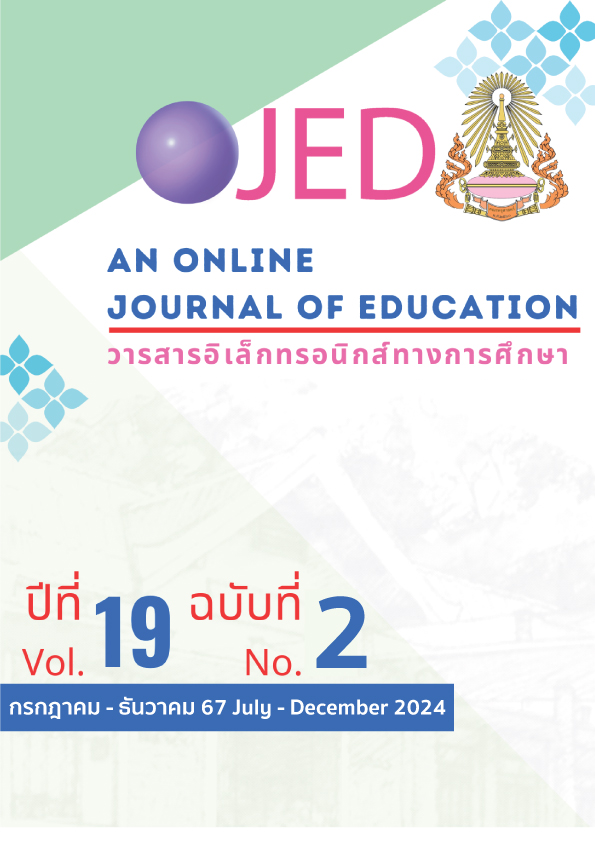The Development of Learning Activities for Third-grade Students Regarding Addition, Subtraction, Multiplication and Division: Using a Bar Model and a STAR Strategy
DOI:
https://doi.org/10.14456/ojed.2024.7Keywords:
development of math learning activities, math problems, bar model, STAR strategyAbstract
The objectives of this study were: 1) to develop learning activities for third-grade students regarding addition, subtraction, multiplication and division using a bar model and a STAR strategy with an 80/80 efficiency index; 2) to compare the learning achievement before and after the activities; and 3) to examine the students’ satisfaction with the activities. The sample group consisted of 16 third-grade students in the first semester of 2023 at Wat Devarajkunchorn School, Dusit District, Bangkok. Research instruments included a math activity development plan, a 20-items math achievement test with a reliability of 0.86 and a satisfaction survey. Statistics used in the study are mean (M), standard deviation (SD) and a dependent t-test. Findings indicate that: 1) the development of learning activities yields a result higher than the 82.42/82.50 efficiency index; 2) the achievement score after the activities is significantly higher than the one before the activities at .05 level; and 3) the level of satisfaction is generally at the highest level, with an average value M = 4.63, SD = 0.08
References
ภาษาไทย
กระทรวงศึกษาธิการ. (2560). ตัวชี้วัดและสาระการเรียนรู้แกนกลาง กลุ่มสาระการเรียนรู้คณิตศาสตร์ (ฉบับปรับปรุง พ.ศ. 2560) ตามหลักสูตรแกนกลางการศึกษาขั้นพื้นฐานพุทธศักราช 2551. สำนักงานคณะกรรมการศึกษาขั้นพื้นฐาน. กระทรวงศึกษาธิการ. โรงพิมพ์ชุมนุมสหกรณ์การเกษตรแห่งประเทศไทย.
จันตรา ธรรมแพทย์ (2550). การพัฒนาแบบฝึกทักษะการแก้โจทย์ปัญหาคณิตศาสตร์ สำหรับนักเรียนช่วงชั้นที่ 2 ที่มีผลสัมฤทธิ์ทางการเรียนคณิตศาสตร์ตํ่า [วิทยานิพนธ์ปริญญามหาบัณฑิต ไม่ได้ตีพิมพ์]. มหาวิทยาลัยราชภัฏจันทรเกษม.
ชัยยงค์ พรหมวงศ์. (2556). การทดสอบการทดสอบประสิทธิภาพสื่อหรือชุดการสอน. วารสารศิลปากรศึกษาศาสตรวิจัย, 5(1), 7-20.
ดารณี เกตุประกอบ. (2564) การศึกษาความสามารถในการแก้โจทย์ปัญหาและผลสัมฤทธิ์ ทางการเรียน เรื่อง การบวกและการลบ โดยใช้กระบวนการแก้ปัญหาตามแนวคิดของโพลยาร่วมกับเทคนิคบาร์โมเดล สำหรับนักเรียนชั้นประถมศึกษาปีที่ 4 [วิทยานิพนธ์ปริญญามหาบัณฑิต ไม่ได้ตีพิมพ์]. มหาวิทยาลัยบูรพา
เปตา กิ่งชัยวงศ์. (2545). การพัฒนาแบบฝึกเรื่องเศษส่วน ชั้นประถมศึกษาปีที่ 3. [การศึกษาค้นคว้าอิสระการศึกษามหาบัณฑิต, มหาวิทยาลัยมหาสารคาม].
พรพรรษา เชื้อวีระชน. (2553). การพัฒนาแบบฝึกทักษะวิชาคณิตศาสตร์ เรื่อง โจทย์ปัญหา เศษส่วนสำหรับนักเรียนชั้นมัธยมศึกษาปีที่ 1 [วิทยานิพนธ์ปริญญามหาบัณฑิต ไม่ได้ตีพิมพ์]. มหาวิทยาลัยนเรศวร.
พรเพ็ญ ศรีเกษม. (2562). การแก้โจทย์ปัญหาทางคณิตศาสตร์ด้วยการจัดการเรียนรู้โดยใช้กลวิธี STAR ร่วมกับบาร์โมเดลของนักเรียนชั้นประถมศึกษาปีที่ 3. วารสารราชนครินทร์, 16(1), 109-117.
ภัทรลภา เปี่ยมสุข. (2563). การพัฒนาความสามารถในการแก้โจทย์ปัญหาคณิตศาสตร์โดยการจัดการเรียนรู้ด้วยรูปแบบการ
สอนเอสเอสซีเอสร่วมกับการวาดรูปบาร์โมเดล ของนักเรียนชั้นประถมศึกษาปีที่ 3 [วิทยานิพนธ์ปริญญามหาบัณฑิต, มหาวิทยาลัยเทคโนโลยีราชมงคลธัญบุรี].
โรงเรียนวัดเทวราชกุญชร. (2565). รายงานผลประเมินคุณภาพผู้เรียน ชั้นประถมศึกษาปีที่ 3 (NT) ประจำปีการศึกษา 2564.
วรณัน ขุนศรี. (2546). การจัดการเรียนการสอนคณิตศาสตร์. วารสารวิชาการ. 6(3), 73-75.
ศิริลักษณ์ ใชสงคราม. (2562). การพัฒนาความสามารถการแก้โจทย์ปัญหาคณิตศาสตร์ของนักเรียนชั้นประถมศึกษาปีที่ 5 ที่จัดการเรียนรู้ด้วยเทคนิค TGT ร่วมกับบาร์โมเดล (Bar Model) [วิทยานิพนธ์มหาบัณฑิต, มหาวิทยาลัยศิลปากร].
สถาบันส่งเสริมการสอนวิทยาศาสตร์และเทคโนโลยี. (2562). หนังสือเรียนรายวิชาพื้นฐานคณิตศาสตร์ชั้นประถมศึกษาปีที่ 3 เล่ม 1 กลุ่มสาระการเรียนรู้คณิตศาสตร์ (ฉบับปรับปรุง พ.ศ. 2560) ตามหลักสูตรแกนกลางการศึกษาขั้นพื้นฐาน พุทธศักราช 2551. โรงพิมพ์ สกสค. ลาดพร้าว.
สมบูรณ์ พรมท้าว. (2547). การพัฒนาแบบฝึกทักษะการแก้โจทย์ปัญหาการคูณ การหารชั้นประถมศึกษาปีที่ 4 [วิทยานิพนธ์มหาบัณฑิต, มหาวิทยาลัยมหาสารคาม].
สุริยัน เขตบรรจง และ ปาวาริศา สมาฤกษ์. (2565). การพัฒนากิจกรรมการเรียนรู้คณิตศาสตร์ เรื่องโจทย์ปัญหาเศษส่วนโดยใช้เทคนิค KWDL ของนักเรียนชั้นมัธยมศึกษาปีที่ 1.วารสารครุศาสตร์, 50(1). https://doi.org/10.58837/CHULA.EDUCU.50.1.11
สำนักทดสอบทางการศึกษา สำนักงานคณะกรรมการการศึกษาขั้นพื้นฐาน. (2565). คู่มือการประเมินคุณภาพผู้เรียน (NT) ชั้นประถมศึกษาปีที่ 3 ปีการศึกษา 2565. (ม.ป.ป.). https://drive.google.com/file/d/18JQtXeFi8tnN2B8_k2KXTvhCkD89Ubyl/view?fbclid=IwAR35m-OsIF1hNNZS8H73Lch1CEYKQUkARE9CGU8T6auQRriOg4N8TJrv67M
อัมพร ม้าคนอง. (2557). คณิตศาสตร์การสอนและการเรียนรู้. ศูนย์ตำราและเอกสารทางวิชาการ. จุฬาลงกรณ์มหาวิทยาลัย
อุรารักษ์ ลากุลเพลิน. (2557). การพัฒนาแบบฝึกทักษะแก้ปัญหาการบวก ลบ คูณ หารระคน โดยการจัดการเรียนรู้เทคนิคกลุ่มช่วยเหลือเป็นรายบุคคลกับเทคนิค KWDL สำหรับนักเรียนชั้นประถมศึกษาปีที่ 4 [วิทยานิพนธ์ปริญญามหาบัณฑิต, มหาวิทยาลัยมหาสารคาม].
ภาษาอังกฤษ
Bruner, J. S. (1993). Explaining and interpreting: Two ways of using mind. In G. Harman (Ed.), Conception of the human mind: Essays in honor of George A. Miller. Lawrence Erlbaum Associates.
Cheong, Y. K. (2002). The model method in Singapore. The Mathematics Educator, 6(2), 47–64.
Ebel, R.L. and Frisbie, D.A. (1986). Essentials of Educational Measurement. Englewood Cliffs, New Jersey: Prentice-Hall.
Maccini, P. & Gagnon, J. (2011). Mathematics Strategy Instruction (SI) for Middle School Studentswith Learning Disabilities.
Maccini, P., & Hughes, C. A. (2000). Effects of a Problem-Solving Strategy on the Introductory Algebra Performance of Secondary Students With Learning Disabilities. Learning Disabilities Research & Practice, 15(1), 10–21. https://doi.org/10.1207/SLDRP1501_2
Maccini, P., & Gagnon, J. (2006). Mathematics strategy instruction (SI) for middle school students with learning disabilities. The Access Center. http://www.k8accesscenter.org/training_resources/massini.asp
Mahoney, K.T. (2012). Effects of Singapore's Model Method on elementary student problem solving performance [Doctoral dissertation, Northeastern University]. Northeastern University ProQuest Dissertations & Theses.
Maslow, A. (1970). Motivation and personality. Harper and Row.
Skinner, B.F. (1953). Science and Human Behavior. New York: Free Press.
Har, Y.B. (2008). Developing mathematical thinking in Singaporeelementary schools. http://archive.criced.tsukuba.ac.jp/data/2009/02/Yeap_Ban_Har.pdf
Downloads
Published
How to Cite
Issue
Section
License
Copyright (c) 2024 An Online Journal of Education

This work is licensed under a Creative Commons Attribution-NonCommercial-NoDerivatives 4.0 International License.




